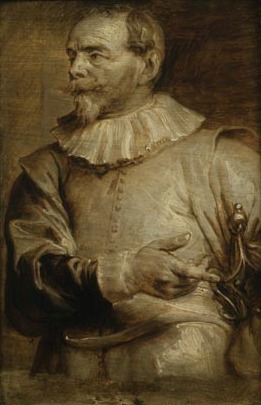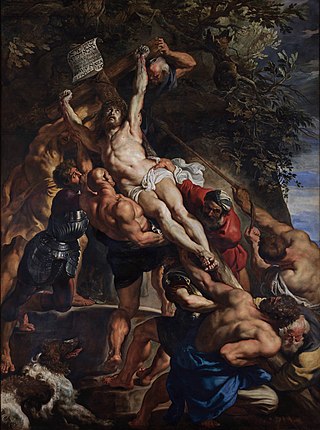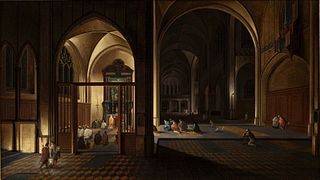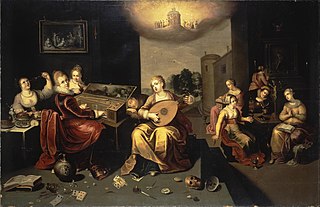Related Research Articles

Herentals is a city in the province of Antwerp. The municipality comprises the city of Herentals proper and the towns of Morkhoven and Noorderwijk. In 2022, Herentals had a total population of 28.455. The total area is 48.56 km2 (18.75 sq mi). Saint Waltrude is the patron saint of the city.
Franken may refer to:

The Francken family was a family of artists the members of which were mainly active in Antwerp in the 16th and 17th centuries. Many of the members over three generations had the same first names Frans, Hieronymus and Ambrosius. While this may at the time have been effective as a marketing method by ensuring continuity of the family business, today's legacy is some confusion in the attribution of paintings, which often do not differ widely in style or execution between the various family members. The confusion is exacerbated by the signing practices of some family members: when Frans I's son Frans II reached his majority and began to sign paintings, Frans I started to add "the elder" to his signature to distinguish himself from his son, who then signed his works as "the younger". This happened again in the next generation when Frans II's son Frans III reached his majority. Frans II then started to sign his works with the elder, while Frans III used Frans the younger.

Jan Snellinck or Jan Snellinck (I) (c. 1548 – 1 October 1638) was a Flemish painter, draughtsman and designer of tapestries, prints and frescoes. He is known for his large altarpieces and was also recognized as a leading battle painter in his time. Snellinck was active as an art dealer and art collector.
The Antwerp School was a school of artists active in Antwerp, first during the 16th century when the city was the economic center of the Low Countries, and then during the 17th century when it became the artistic stronghold of the Flemish Baroque under Peter Paul Rubens.

Sebastiaen Vrancx, Sebastiaan Vrancx or Sebastian Vranckx was a Flemish Baroque painter, draughtsman and designer of prints who is mainly known for his battle scenes, a genre that he pioneered in Netherlandish painting. He also created landscapes with mythological and allegorical scenes, scenes with robbers, village scenes and celebrations in cities. He was a gifted figure painter who was regularly invited to paint the staffage in compositions of fellow painters. As an active member of a local chamber of rhetoric, he wrote comedies and a number of poems. He was further captain of the Antwerp civil militia schutterij.

Flemish Baroque painting was a style of painting in the Southern Netherlands during Spanish control in the 16th and 17th centuries. The period roughly begins when the Dutch Republic was split from the Habsburg Spain regions to the south with the Spanish recapturing of Antwerp in 1585 and goes until about 1700, when Spanish Habsburg authority ended with the death of King Charles II. Antwerp, home to the prominent artists Peter Paul Rubens, Anthony van Dyck, and Jacob Jordaens, was the artistic nexus, while other notable cities include Brussels and Ghent.

Frans Francken the Younger was a Flemish painter and the best-known and most prolific member of the large Francken family of artists. Francken painted a range of subjects, producing large altarpieces for churches as well as smaller historical, mythological and allegorical scenes. His depictions of collectors' cabinets established a popular new genre of art in the era. Francken often collaborated with other artists, adding figures and narrative elements to scenes created by specialists in landscape, architectural scenes, and floral still life painting..

Abraham Govaerts was a Flemish painter who specialized in small cabinet-sized forest landscapes in the manner of Jan Brueghel the Elder and Gillis van Coninxloo. He was a regular collaborator with other artists who were specialists in specific genres. Govaerts would paint the landscape while these specialists painted the figures, animals or still life elements.

Frans Francken I or Frans Francken the Elder was a Flemish painter who was one of the principal painters in Antwerp during the Counter-Reformation. He is mainly known for his large altarpieces and allegorical paintings. He was a member of the Francken dynasty of painters that played an important role in the Antwerp art scene in the late 16th century and the 17th century.

Pieter Neefs the Elder or Pieter Neeffs the Elder was a Flemish painter who specialized in architectural interiors of churches. Active in Antwerp, he was influenced by the works of the Dutch architectural painters Hendrik van Steenwijk the Elder and the Younger. His principal contribution to the genre were his nocturnal church interiors lit by two light sources.

Marten Pepijn was a Flemish painter who was mainly known for his large-scale history paintings and to a lesser extent for his smaller genre scenes.
Van Aken is a Dutch surname meaning "from Aachen ". It may refer to:

Frans Francken III (1607–1667) was a Flemish Baroque painter and the best known member of the fourth generation of the Francken family of artists.

Ambrosius Francken I (1544–1618) was a Flemish painter known for his religious works and historical allegories painted in a late Mannerist style. He was a prominent member of the Francken family of artists, which played a very important role in the Flemish art scene from the late 16th to middle 17th century.

Hieronymus Francken I or Hieronymus Francken the Elder was a Flemish painter and an important member of the Francken family of artists. After training in Antwerp, he was mainly active in France, where he became court painter at the French court. His compositions with elegant groups of dancing figures, musicians and courtiers anticipate the development of this genre in the 17th century.

Hieronymus Francken III, was a Flemish Baroque painter and a well known member of the Francken family of artists.

Hieronymus Francken the Younger or Hieronymus II was a Flemish painter and one of the most prominent members of the large Francken family of artists. Along with his brother Frans Francken II he played an important role in the development of new genres in Flemish art in the early 17th century. He was a prolific artist with a wide range who painted religious scenes, allegorical subjects, portraits, fruit pieces, genre scenes, architectural paintings and art galleries.

The Parable of the Prodigal Son is an oil painting by the brothers Frans Francken the Younger and Hieronymus Francken II, now in the collection of the Amsterdam Museum. It was created sometime between 1610 and 1620 in Antwerp and was acquired by the Amsterdam art collector Adriaan van der Hoop in 1843, who donated it to the city in 1854. It is on long term loan to the Rijksmuseum.